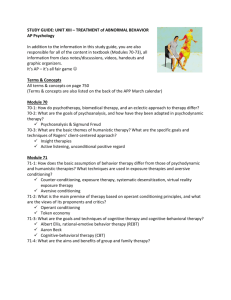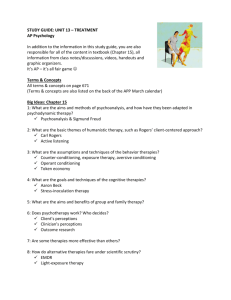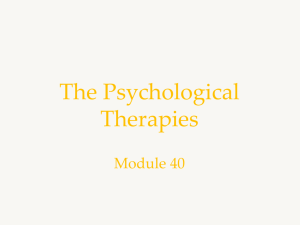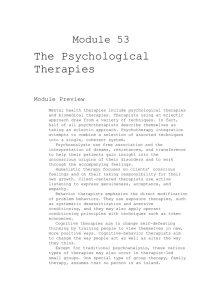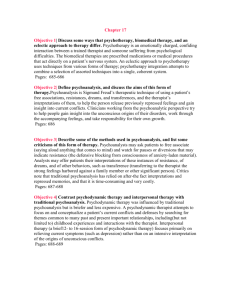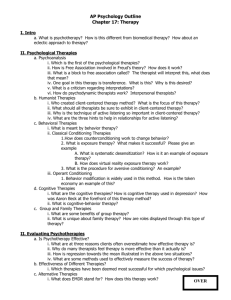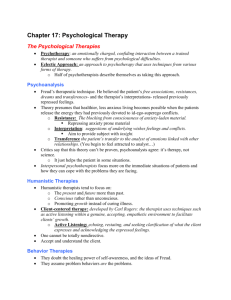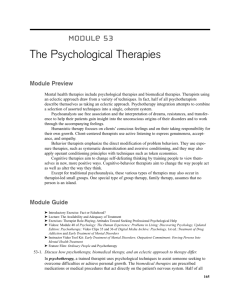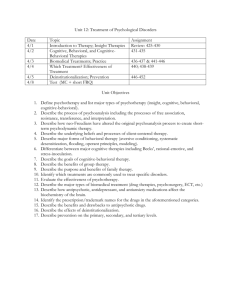586684MyersMod_LG_50
advertisement
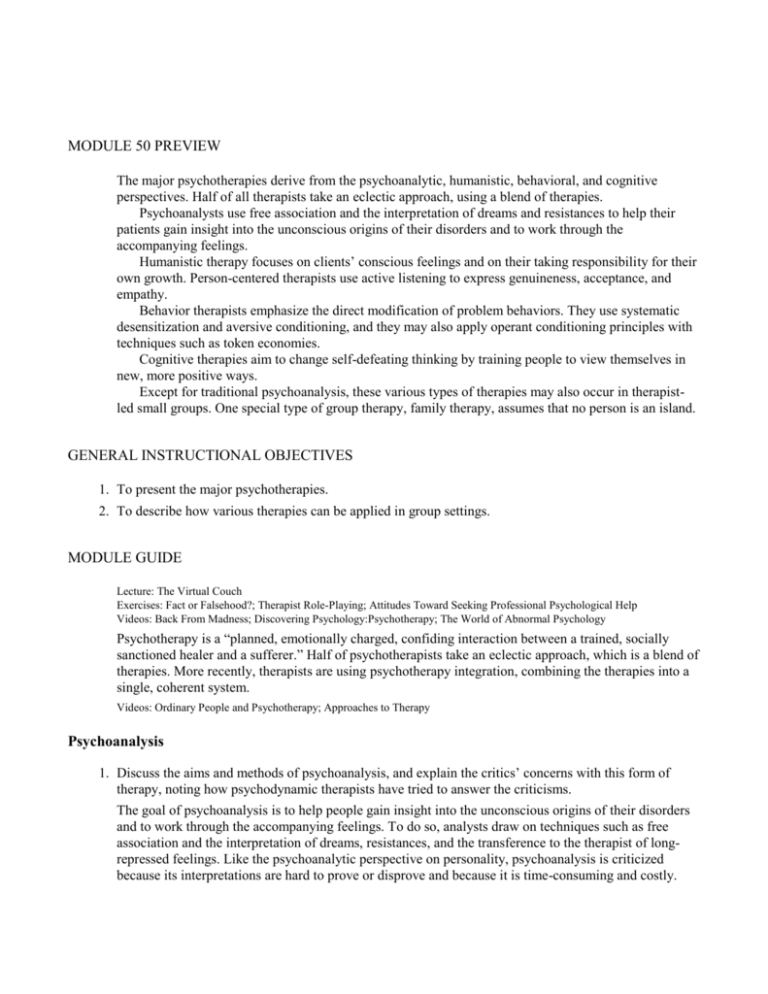
MODULE 50 PREVIEW The major psychotherapies derive from the psychoanalytic, humanistic, behavioral, and cognitive perspectives. Half of all therapists take an eclectic approach, using a blend of therapies. Psychoanalysts use free association and the interpretation of dreams and resistances to help their patients gain insight into the unconscious origins of their disorders and to work through the accompanying feelings. Humanistic therapy focuses on clients’ conscious feelings and on their taking responsibility for their own growth. Person-centered therapists use active listening to express genuineness, acceptance, and empathy. Behavior therapists emphasize the direct modification of problem behaviors. They use systematic desensitization and aversive conditioning, and they may also apply operant conditioning principles with techniques such as token economies. Cognitive therapies aim to change self-defeating thinking by training people to view themselves in new, more positive ways. Except for traditional psychoanalysis, these various types of therapies may also occur in therapistled small groups. One special type of group therapy, family therapy, assumes that no person is an island. GENERAL INSTRUCTIONAL OBJECTIVES 1. To present the major psychotherapies. 2. To describe how various therapies can be applied in group settings. MODULE GUIDE Lecture: The Virtual Couch Exercises: Fact or Falsehood?; Therapist Role-Playing; Attitudes Toward Seeking Professional Psychological Help Videos: Back From Madness; Discovering Psychology:Psychotherapy; The World of Abnormal Psychology Psychotherapy is a “planned, emotionally charged, confiding interaction between a trained, socially sanctioned healer and a sufferer.” Half of psychotherapists take an eclectic approach, which is a blend of therapies. More recently, therapists are using psychotherapy integration, combining the therapies into a single, coherent system. Videos: Ordinary People and Psychotherapy; Approaches to Therapy Psychoanalysis 1. Discuss the aims and methods of psychoanalysis, and explain the critics’ concerns with this form of therapy, noting how psychodynamic therapists have tried to answer the criticisms. The goal of psychoanalysis is to help people gain insight into the unconscious origins of their disorders and to work through the accompanying feelings. To do so, analysts draw on techniques such as free association and the interpretation of dreams, resistances, and the transference to the therapist of longrepressed feelings. Like the psychoanalytic perspective on personality, psychoanalysis is criticized because its interpretations are hard to prove or disprove and because it is time-consuming and costly. The recent challenge to repressed memories, on which much of psychoanalysis is built, is also provoking intense debate. Today, there are few traditional psychoanalysts. Most have been replaced by therapists who make psychodynamic assumptions, that is, those who try to understand patients’ current symptoms by exploring their childhood experiences. Lecture: Good Candidates for Psychoanalysis Film: Freud—The Hidden Nature of Man Humanistic Therapies 2. Identify basic characteristics of the humanistic therapies and the specific goals and techniques of clientcentered therapy. Humanistic therapists focus on clients’ current conscious feelings and on their taking responsibility for their own growth. In emphasizing people’s inherent potential for self-fulfillment, they aim to promote growth rather than to cure illness. In his client-centered therapy, Rogers used active listening to express genuineness, acceptance, and empathy. This technique, he believed, would help clients to increase their self-understanding and self-acceptance. The therapist interrupts only to restate and confirm the client’s feelings, to accept what the client is expressing, or to seek clarification. The client-centered counselor seeks to provide a psychological mirror that helps clients see themselves more clearly. Lecture: Computer-Assisted Psychotherapy Exercises: Role-Playing to Demonstrate Person-Centered Therapy; The Self-Concealment Scale; The Imposter Phenomenon Project: ELIZA—An Interesting Web Site; Dibs and Play Therapy PsychSim: Computer Therapist Behavior Therapies 3. Identify the basic assumptions of behavior therapy and discuss the classical conditioning techniques of systematic desensitization, flooding, and aversive conditioning. Instead of trying to alleviate distressing behaviors by resolving a presumed underlying problem, behavior therapists apply well-established learning principles to eliminate the unwanted behavior. They try to replace problem thoughts and maladaptive behaviors with more constructive ways of thinking and acting. Both systematic desensitization and aversive conditioning are types of counterconditioning, a procedure that conditions new responses to stimuli that trigger unwanted behaviors. In systematic desensitization, a prime example of exposure therapy, a pleasant, relaxed state is associated with gradually increasing anxiety-triggering stimuli. This procedure is commonly used to treat phobias. Flooding, a more aggressive therapy, is an extinction procedure that forces a person to confront feared stimuli. In aversive conditioning, an unpleasant state (such as nausea) is associated with an unwanted behavior (such as drinking alcohol). Lecture: The Self-Injurious Behavior Inhibiting System Exercise: Using Systematic Desensitization to Treat Eraser Phobia Project: Practicing Systematic Desensitization Videos: Module 30 of The Mind Series, 2nd ed.; Segment 31 of the Scientific American Frontiers Series, 2nd ed.; Harry— Behavioral Treatment of Self-Abuse; Don’t Panic—The Promise of Intensive Exposure Therapy Transparencies: 158 Systematic Desensitization of a Phobia; 159 Aversion Therapy for Alcoholics 4. Describe therapeutic applications of operant conditioning principles and explain the critics’ concerns with this behavior modification process. Behavior therapists apply operant conditioning principles by reinforcing desired behaviors while withholding reinforcement for undesired behaviors. The rewards used to modify behavior vary, from attention or praise to more concrete rewards such as food. In institutional settings, therapists may create a token economy in which a patient exchanges a token of some sort, earned for exhibiting the desired behavior, for various privileges or treats. Video: Token Economy: Behaviorism Applied Critics express two concerns: First, what happens when the reinforcers stop? Might the person have become so dependent upon the extrinsic rewards that the appropriate behaviors quickly disappear? Second, is it ethical for one person to control another’s behavior? Lecture: Therapy and Totalitarian Control Exercises: Modeling; Assessing Assertiveness Project: Modifying an Existing Behavior Cognitive Therapies 5. Describe the assumptions and goals of the cognitive therapies and their application to the treatment of depression. Cognitive therapists assume that our thinking colors our feelings, and so they try to teach people who suffer psychological disorders new, more constructive ways of thinking. In treating depression, Aaron Beck seeks to reverse clients’ catastrophizing beliefs about themselves, their situation, and their future. His technique is a gentle questioning that aims to help people discover their irrationalities. Other therapists teach depressed adults to interpret life events as nondepressed people do, for example, to take credit for their successes. Still other cognitive therapists combine the reversal of self-defeating thinking with efforts to modify behavior. Cognitive-behavior therapy aims to make people aware of their irrational negative thinking, to replace it with new ways of thinking and talking, and to practice the more positive approach in everyday settings. Lectures: Strategies to Correct One’s Thinking; Overcoming the Fear of Public Speaking Exercises: Frequency of Self-Reinforcement Questionnaire Transparency: 160 A Cognitive Perspective on Psychological Disorders Group and Family Therapies 6. Describe the rationale and benefits of group therapy, including family therapy. The social context provided by group therapy allows people to discover that others have problems similar to their own and to try out new ways of behaving. Receiving honest feedback can be very helpful, and it can be reassuring to find that you are not alone. Many participate in self-help and support groups—for substance abusers, divorced people, gamblers, the bereaved, and those simply seeking personal growth. Family therapy assumes that we live and grow in relation to others, especially our families. In an effort to heal relationships, therapists help family members discover the role they play within the family’s social system. Lecture: Psychodrama
